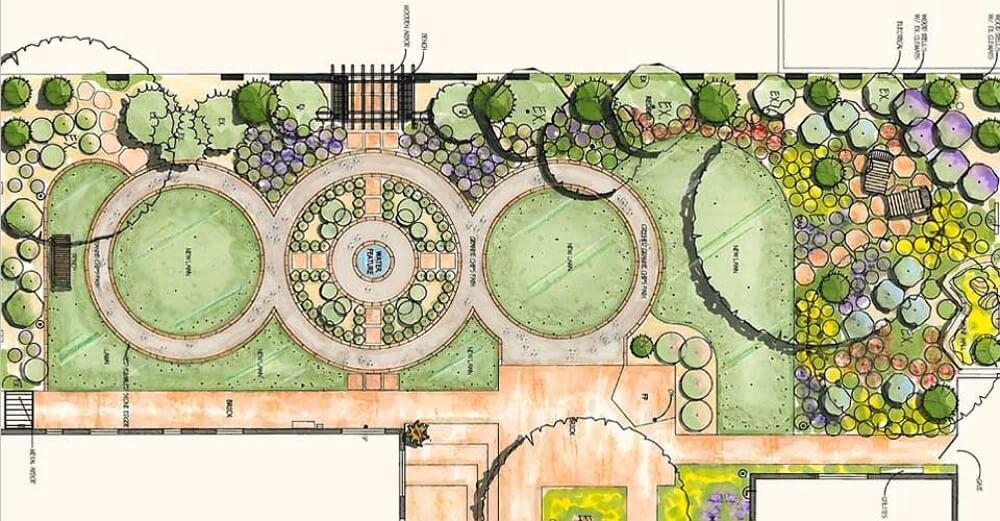The Basic Principles Of Landscapers
The Basic Principles Of Landscapers
Blog Article
Landscapers Can Be Fun For Anyone
Table of ContentsWhat Does Landscapers Mean?Landscapers Things To Know Before You BuyLandscapers Things To Know Before You Get ThisFascination About LandscapersLandscapers - TruthsLandscapers - An Overview
- A garden attribute where water is represented by an aggregate stone product, generally a gravel or granite. These are most typically found in contemporary and Japanese yard design.- A stone or flagstone patio area, path, or pathway constructed without a concrete base. The base would certainly be compacted crushed rock and the joints would be an accumulation or walkable ground cover. - A stone keeping or complimentary standing wall surface developed without the use of mortar. - An underground structure that gather water and enables it to slow down percolate into the soil around it.
Landscape style that is compatible with a sites' environment in both look and sustainability without unfavorable impacts to the setting. Bordering in the landscape is a line of separation that produces visual passion in the garden by separating one segment from an additional section.
Locations can also have a sensation of "enclosure" given by trees, various other plantings, fencings, or displays. The landscape near the entrance to a structure.
The Main Principles Of Landscapers

The component in a landscape layout or area in a landscape that is implied to be most noticeable. The centerpiece can be a plant, boulder, sculpture, gathering space, or other landscape feature. A design of yards or yard components that worry straight lines, ideal angles and circles. Shrubs or hedges situated in beds near the structure of a home or various other structure.

All about Landscapers
Reduced plants that are enabled or motivated to spread out over a location. Can refer to any kind of "tough" garden elements consisting of statuary or stones but a lot of generally is made use of to refer to courses, patios, and walls - Landscapers.: Height distinction between the level of water in a fish pond (or the level of the pump if it rests outside the pond) and the top outlet of water which impacts performance of the water pump in gph (gallons per hour).
A chemical made use of to manage weeds. Fence boards that run horizontally, commonly used in modern-day or Japanese-inspired landscape layouts. Lines that define rooms within a landscape concept. These frequently prolong from edges or essential features of an existing structure. Proper use fictional lines can aid the landscape really feel linked to the home and other aspects.
A more unwinded garden controlled by bent as opposed to straight bed lines and a less stiff structure. Traditional PNW landscapes are casual. A plant that spreads out more than desired, or into environments where it does damages. Portland has a checklist of intrusive plants that should not be installed in landscapes because they can infect woodlands or waterways and be difficult to regulate.
A Biased View of Landscapers
Can consist informative post of head placements and protection, pipe sizing, GPM specifications, and products required to install this system. Accredited specialist that designs landscapes, coached in engineering and style as well as in horticulture.
Landscape developers typically have less schooling than Landscape Architects and are not accredited. A finished landscape layout, detailing all elements for the brand-new landscape.
Using several plantings of the same selection to fill up in a location in the landscape. This can lower upkeep and water use in the yard.
A mix of concrete, sand, and water that is used in stone stonework for establishing stones and joints. A layer of garden compost or bark you could check here dust used at the base of a plant. A mass planting of moss. A plant that was present in a geographical place prior to people began altering the landscape.
8 Easy Facts About Landscapers Shown
Exactly how the yard or a yard element is set up in partnership to an existing or new attribute or to an instructions. Maintaining a yard without making use of chemical herbicides, pesticides, or plant foods. Lawns that are not cut however expanded in landscapes as perennials. This is a partly open sided relaxation or entertainment location that joins a home, utilized for enjoyable, outdoor eating and merely taking pleasure in the exterior setting.

Small round crushed rock. Plants that give seasonal passion and afterwards die back in the winter season. Annuals do not come back the adhering to period, however perennials do. Winter season grass that is one of the most typical turf yard in Rose city, OR and the rest of the PNW.An open roofed framework over a patio area or other landscape feature.
Basalt aggregate ranging in size from 1/4" to dust. The most typical landscape gravel in the PNW. Location of the landscape created to handle water until it can saturate right into the ground. A chain that controls water as it takes click now a trip from a roofing system seamless gutter to the ground. Garden framework that produces a planting area that is had and greater than the bordering grade.
Creating a garden attribute being composed primarily of rocks with growings that complement and can flourish in the rocky setting. Lawn sprinkler head style that turns a stream of water throughout a location.
The Basic Principles Of Landscapers
:max_bytes(150000):strip_icc()/GettyImages-154046398-c39f1daf45a84601b328d78ed8630660.jpg)
Report this page